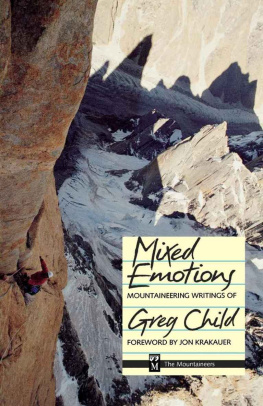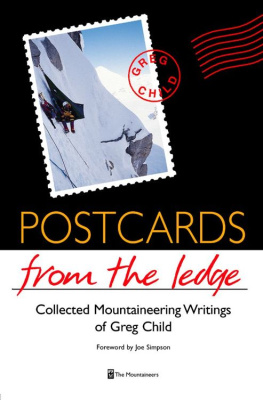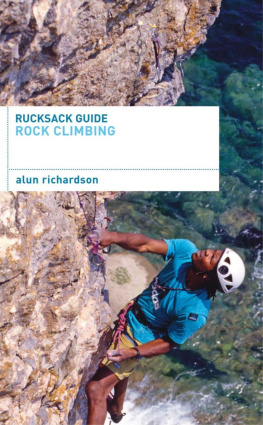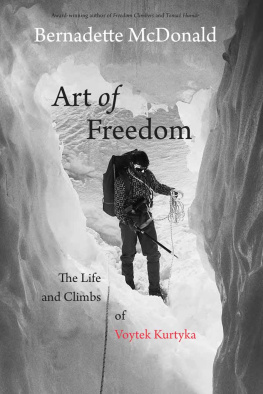MIXED
EMOTIONS
MIXED
EMOTIONS
Mountaineering Writings of
GREG CHILD


| Published by
The Mountaineers
1001 SW Klickitat Way, Suite 201
Seattle, Washington 98134 |
Published simultaneously in Great Britain by Cordee, 3a DeMontfort Street, Leicester, England, LE1 7HD
1993 by Greg Child
All rights reserved
First edition: first printing 1993, second printing 1994, third printing 1996, fourth printing 1997, fifth printing 2000
No part of this book may be reproduced in any form, or by any electronic, mechanical, or other means, without permission in writing from the publisher.
Manufactured in the United States of America
Edited by Linda Gunnarson
Cover photographs Greg Child
Cover design by Helen Cherullo
Book design and typesetting by The Mountaineers Books
Library of Congress Cataloging in Publication Data
Child, Greg.
Mixed emotions : mountaineering writings of Greg Child.
p. cm.
ISBN 0-89886-363-5
1. Mountaineering. 2. Mountaineers. 3. Child, Greg. I. Title.
GV200.C45 1993 | 93-28737 |
796.5'22dc20 | CIP |
To Salley Oberlin
CONTENTS
There is no excellent beauty that
hath not some strangeness
in the proportion.
Francis Bacon (15611626)
FOREWORD
SERIOUS CLIMBING, Greg Child has observed, treads a thin line between recklessness and calculated risk, the path marked only by intuition, a capricious and often flawed instinct. But Childs own instinct in such matters appears to be anything but flawed; how else to explain the fact that this wry, compact Australian is still in the company of the living?
Face to face, Child comes across as humble, thoughtful, quick to tell a joke on himself. There is nothing in his unassuming bearing to suggest that you are in the presence of an exceedingly bold and accomplished climber. To immerse oneself in the pages of this book, though, is to gain a quick and sometimes disturbing appreciation of the seriousness of Childs deeds in high placesthe razor-thin margin for error, the unrelenting intensity, the scarcely imaginable physical and mental demands.
Among the premier climbers of the late twentieth century, Child stands out for his unwillingness to specialize, for his refusal to limit his activities to any single facet of the vertical oeuvre. Childs virtuosity encompasses the full mountaineering spectrumfrom short, tendon-ripping sport climbs in the modern idiom to ten-day A5 horror shows on the massive stone flanks of El Capitan to the most elusive summits of the high Himalaya. How many other alpinists can say theyve been to the summit of K2 and red-pointed 5.13 routes at Arapiles and Smith Rock?
To climb brilliantly on ice, on rock, and at altitude is rare enough. But Child is a writer to boota damn good writer, as it happens, the real deal, the author of pieces esteemed as classics in the genre. A number of these classicsincluding Lost in America, On Broad Peak, and Coast to Coast on the Granite Slasher (which, astonishingly, was the first piece Child ever wrote for publication)will be found between the covers of this collection.
Never trust the written word, Child writes in the first line of Granite Slasher. At best its a second-rate account of reality. How can you duplicate the enormity of a personal moment? How can you truthfully record the feelings or events when the intricacies of each second of thought would fry the circuits of a computer? How, indeed? I am at a loss to explain it, but Child has done nothing less in these pages, his opening disclaimer notwithstanding. This volume holds tragedy and great drama, troubling insights, gallows humor, flashes of beauty so intoxicating they take ones breath away. Mixed Emotions is an unforgettable book. Read it and marvel.
Jon Krakauer
Seattle, 1993
PREFACE
IVE NEVER BEEN CERTAIN whether Im a climber who writes or a writer who climbs. Torn between both, I have probably wasted a good deal of time writing when I could have been climbing, or climbing when I should have been writing. Still, I cant complain. Climbing has been good to me, giving me passion and purpose for more than twenty years, and giving me the raw material and the courage to write.
This collection of stories covers a lot of ground, from first ascents on the rock faces of El Capitan to summits of Himalayan massifs such as Gasherbrum IV, Trango Tower and K2, to treks in remote Nepal, to profiles of climbers I admire. For the most part, the setting for these tales is that strange world of high altitude. Some of these stories have appeared in magazines such as Climbing, Rock + Ice, Outside, Backpacker, Summit, Mountain in Great Britain, and Rock in Australia. Others have incubated in my journals before finding their place here.
I must admit, Ive often felt mixed emotions about the life of climbing. Perhaps thats because so many friends have died in the mountains. Even so, throughout the last thirteen years and dozen expeditions, my wife, Salley Oberlin, has encouraged my climbing and my writing and has shared many climbing days with me. I thank her for letting me be what I am.
To most people, pursuing difficult and abstract goals like climbing mountains, and risking life and limb while doing it, is insanity, at best eccentricity. I tend to agree, in part, with that line of thinking. I will say, though, that the climbing experiences Ive endured have made me feel my life acutely. The challenge of trying to capture those strange, quintessential moments when climbs were overwhelming me physically and emotionally was what prompted me to write in the first place. I dont pretend to fathom the reasons people climb, but by recounting the events, feelings and landscapes in which climbers immerse themselves we might find some clue to it all.
Greg Child
Seattle, 1993
EPIC!
TRANSLATED FROM THE LINGUA FRANCA of climbing to laypersons lingo, an epic is a bad day at the office on a cosmic scale. Many types of climbing experience qualify as epic: grand adventures, mind-bendingly terrifying ordeals, flirtations with disaster, character-building experiences. An uncomfortable bivouac on a ledge or getting benighted on a climb can qualify as epics too. So might a thorough soaking in a storm, or a long, tiring climb with hunger and thirst nibbling at your guts. Epics are a good reason to quit climbing, an awful time, and a heap of fun all rolled into one. Epics define us as climbers. Sometimes they destroy us. A climber having a proclivity for epics is termed an epic-monger. Such as myself, I suppose.
Taking the Plunge, written in 1993, is an unreliable memoir about growing up in Australia, being bitten by a deadly snake and taking a hundred-foot nosedive onto the ground from a rock climb. The Law of High Places, also written in 1993, examines the phenomenon of fear and the role it played in my more eventful climbs. On a more serious note is The Obscure Object of Desire, which was written after a shivering bivouac near the summit of a 26,000-foot mountain called Gasherbrum IV. It appeared in 1986 in Climbing and the American Alpine Journal.
On Broad Peak describes another type of epica tragedy. Until 1983 I didnt know much about storytelling, but then a trip to the Karakoram to a mountain called Broad Peak came along. The climba tragic and harrowing experience during which I lost a friend, and upon which I still often reflect, ten years laterwas an important point in my life. The experience troubled me deeply, yet the world of high mountains exhilarated me too. I had feelings to purge and a need to examine myself. I picked up a pen and paper the day I returned home and quickly wrote the tale. On Broad Peak appeared in









